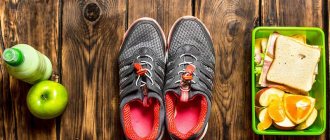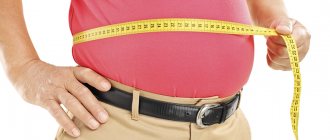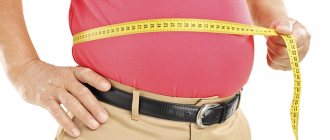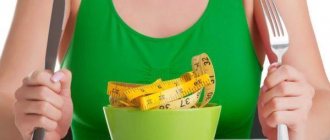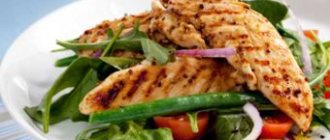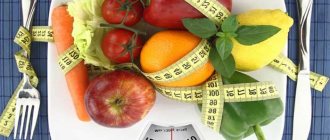The vast majority of people, in our fast-paced age, are increasingly thinking about the topic of proper nutrition. There are several important reasons for this. Firstly, proper nutrition allows you to feel cheerful and fresh, and secondly, it helps to maintain weight in a certain category.
Today we will look at a menu for 1300 calories per day. Looking ahead, it should be noted that this menu is perfect for both men and women, both for losing weight and maintaining weight.
1300 calorie meal
The minimum daily calorie intake for adults is 1200 calories. However, when doing physical labor or sports, this figure increases sharply and amounts to 1500 calories or more. Thus, a balanced menu of 1300 calories will be the golden mean.
The main condition is to find the right balance with kbju. It is the clear distribution of the main groups of elements that is the key to the success of any balanced diet.
Kbju is a generally accepted formulation of the main elements (calories, proteins, fats, carbohydrates) when compiling a pp menu.
Norm and formula
Balancing kbju is strictly individual and is developed directly for a specific person.
Factors influencing the calculation:
- Sex differences;
- Age category;
- Lifestyle at the time of counting;
- The goal, that is, what you are trying to achieve - losing weight, gaining weight or maintaining it;
- Human metabolism.
Next, the calculation formula is used. There is no strictly defined formula, so nutritionists use the most effective ones, based on the above characteristics.
We will use a formula that is generally accepted by many nutritionists from different countries.
Calculation formula for women:
9.99 x exact weight in kg + 6.25 x exact height in cm –4.92 x full age in years – 161
Calculation formula for men:
9.99 x exact weight in kg + 6.25 x exact height in cm – 4.92 x full height in years + 5
We get a strictly defined figure, these are the calories that you spend every day, even if you just lie on the couch and sometimes move your arm or leg.
Next, you should multiply the resulting amount by KA (activity coefficient).
The coefficient directly depends on lifestyle:
- Absolutely passive image or permanently sedentary work, no sports, KA is 1.2;
- Light physical activity twice a week, KA is 1.4;
- If you are on the move or visit the gym 3-5 times, then KA is 1.46;
- Full-time classes in the gym 5 times a week – 1.55;
- Daily sports activities – 1.63;
- Exercising twice a day, throughout the week – 1.72;
- Work associated with constant physical activity, or playing sports with full effort twice a day – 1.9.
For example, let’s take my indicator and calculate the norm together:
1337 x 1.4 = 1872 kilocalories (kcal).
This is exactly the amount of food my body needs to constantly maintain weight.
To gradually lose weight, you need to subtract ten percent, and to gain weight, add it accordingly.
1872 – 10% = 1685 kcal. For weight loss.
1872 + 10% = 2059 kcal. For recruitment.
You can increase the percentage for faster results. However, in this case, the body will be subject to severe stress, and this can lead to undesirable consequences.
It is extremely difficult to absolutely maintain these numbers, so they resort to a “calorie corridor.” The minimum limit of which drops to – 250 kcal, and the maximum rises to + 100 kcal.
Calculate your ideal weight
Quitting the diet
It is impossible for healthy people to diet endlessly. When planning to return to a more normal diet, there are a few things to consider. The main recommendation is a smooth transition. There should be no sudden replacement of one eating habit with another. Even after a diet, it is better to follow the advice of experts.
Important Recommendations:
- daily caloric intake should be gradually increased to the usual daily norm. Approximately 50 kilocalories should be added every week;
- during one day you need to eat no more than 5 grams of carbohydrates per kilogram of body;
- You should have a low-carb day at least once a week. To do this, you can use the recipes of the dishes proposed above;
- You need to drink at least 2 liters of clean water per day;
- 90% of dishes should be cooked in the oven or steamed. You can boil it if necessary;
- You need to do light physical exercise every day. This is necessary to maintain shape.
1300 calorie diets with recipes
A simple menu for a given amount of calories, very comfortable and convenient, you won’t have to go hungry.
The advantages include:
- Accelerated metabolism;
- Improvement of skin;
- The condition of hair and nails noticeably improves;
- Increased tone, improved well-being;
- The appearance of lightness.
Minuses:
- Feeling hungry in the first days;
- Fast fatiguability;
- Dizziness;
- Fainting.
With prolonged use of a diet for such a number of calories, there is a decline in efficiency, as well as a decrease in metabolism.
Weekly menu with simple ingredients
All recipes are very simple, prepared from available products.
Day 1 - 1314 kcal. (BZHU - 78/31/180)
7.30 – 220 g of oatmeal, prepared with low-fat milk, with the addition of 60 g of fresh berries. Walnut - 10 g. Black coffee or unsweetened tea.
11.30 – green apple – 170 g.
14.30 – 120 g buckwheat porridge with milk 1.5% fat. Salad-250 g: cucumber, tomato, green. peas, carrots, egg, yogurt.
16.30 – banana – 120 g. Herbal tea.
18.30 – chicken breast salad with vegetables (tomato, cucumber, herbs), dressed with yogurt. Chicory with milk.
19.30 — A glass of kefir with one slice.
Day 2 - 1301 Kcal (BJU -110/32/138)
7.30 – 210 g low-fat cottage cheese – 200 g, banana – 100 g. Black coffee or tea without sugar.
11.30 – orange – 130 g, raw carrots – 150 g.
14.30 – boiled brown rice – 120 g, steamed salmon small portion, 250 g, seasoned vegetable salad 1 tsp. butter - 200 g.
16.30 – 30 g of black bread with low-fat cottage cheese and one tomato. Tea.
18.30 – small portion of omelette with vegetables, chicory with milk.
19.30 - green apple.
Day 3 - 1305 Kcal (BZHU-100/43/133)
7.30 –220 g oatmeal cooked with low-fat milk. Add one grated apple and one teaspoon of cinnamon to the porridge. Coffee.
11.30 – half a grapefruit, walnut – 10 g.
14.30 – vegetable soup, one serving. 30 g rye bread with herring.
16.30 – yogurt with berries (can be fresh frozen).
18.30 – cottage cheese casserole – 200 g without sugar. To prepare, you need to take low-fat cottage cheese, kefir, egg, and oat bran. Bake like a regular casserole. Tea.
Just before bed – chicory with milk + slice.
Day 4 - 1300 Kcal (BJU - 109/20/170)
7.30 – 80 g of dry muesli diluted with kefir (200 ml). Half a grapefruit, black coffee or tea.
11.30 – green apple – 180 g.
14.30 – chicken breast soup: chicken fillet – 80 g, potatoes – 100 g, buckwheat – 25 g, green peas – 50 g, herbs – 15 g. One slice.
16.30 – 50 g of black bread with low-fat cottage cheese and one tomato.
18.30 – steamed white tilapia fish 190 g. Vegetable salad: tomato – 100 g, cucumber – 100 g, green peas – 50 g, radishes – 50 g, carrots – 50 g, greens – 15 g, season with yogurt – 60 ml.
4-7 day
- Day 4 - repeat 1st
- Day 5 - repeat 2nd
- 6th day - repeat 3rd
Day 7 – cheat meal!!
We eat everything we wanted all week, but couldn’t, but we try not to go off the scale in calories! You can afford delicious and healthy chickpea candies, for example.
Products for 6 days:
- white rice – 200 g;
- buckwheat – 200 g;
- millet – 40 g;
- oat flakes – 150 g;
- chicken breast – 1000 g;
- turkey – 1000 g;
- fish – 800 g;
- pasta – 400 g;
- vegetables (frozen mixture, pickled) – 1 kg;
- seaweed – 10 g;
- cucumber (fresh, salted) - 400 g;
- Beijing - 400 g;
- carrots – 500 g;
- onions - 200 pcs;
- egg – 10 pcs;
- potatoes – 500 g;
- banana – 2 pcs;
- raisins – 20 g;
- lentils - 100 g;
- central bread – 400 g;
- lemon – 1 piece;
- Armenian thin lavash – 1 piece;
- greens, olive oil – 60.
You can also look at the recipes in the section PP and weight loss, there are dishes with the calculation of KBZHU, you can replace some of the above to leave a menu for the day or week.
Basic rules of proper nutrition
There are a number of mandatory rules to ensure that food not only tastes good, but also brings maximum benefits.
- Meals should be eaten five times a day.
- The dish should not exceed 250 g.
- Water should be consumed up to three liters; juice, tea and coffee are not a substitute.
- Carbohydrates are consumed in the first half of the day, as they are absorbed over a long period of time.
- Protein, on the contrary, is absorbed quickly, and therefore it should be transferred to the second half of the day.
- An excellent source of fats are nuts.
- Fiber, as well as essential vitamins, can be found in fruits.
How to get out of a diet correctly
Anyone who has taken a weight loss course knows very well that losing extra pounds is only half the battle. The second part is to hold the resulting mass.
You should come out of the 1300 calorie diet slowly, one might say in stages.
There is no point in constantly being at this mark. The fact is that over time, the body adapts to your diet and the weight loss effect will disappear.
The amount of calories consumed should be increased gradually. For the first three days, add one hundred calories, then two hundred, three hundred until you reach your usual diet.
Expert advice
- You need to eat at specially designated hours.
- Look at things realistically. Experts advise a gentle approach - minus a kilogram in one week. The result of long-term weight loss lasts longer.
- Incentives. Give yourself occasional surprises after achieving intermediate results. This way you can cope with nervous tension more easily.
- Don't despair under any circumstances. We didn’t lose the treasured kilogram or overeat sweets, nothing bad happened. Return to eating healthy the next morning.
- Exercise. If you don't want to go to the gym, walk, do gymnastics.
- Swap out regular dishes for smaller ones.
It is necessary to clearly understand that no diet will help if there is no proper nutrition. When thinking about what to eat for lunch or dinner, pay attention to the amount of useful and active substances. Just one indulgence can undo all your efforts.
Will the diet work?
Many people who are losing weight are captured by a very useless and dangerous misconception: they think that what you eat is important, and not how much. So Kostya Shirokaya is absolutely against this myth. You don't need to eat only grapefruits, oatmeal and chicken breast in order to finally get rid of those extra pounds around your waist!
Your friend is moderation in nutrition and choosing the right foods just for you! Well, buckwheat doesn’t bother you, although the phytony Masha, foaming at the mouth, claims that a real PPshnik should not live without this cereal. Or broccoli causes nervous diarrhea. And chia seeds are simply beyond your wallet!
So we give you an indulgence: don’t eat what you don’t want and don’t spend your last money on dubious superfoods . For your slimness, the number of calories you get per day is paramount; read more in the article “What is more important: food quality or calories?” .
Despite the fact that there are simply a shocking number of myths in the field of nutrition and weight loss, this statement is beyond doubt, read, for example, If you want to lose weight, don’t eat carbohydrates .
The 1300 kcal diet more than works. True, we personally think that this is a very small calorie content, but in the end it all depends on your goals and the period of time that you have.
Pros and cons of diet for every day
- you will not feel hungry;
- you will not be haunted by stomach pain, fatigue, or headache;
- you will snack correctly and not gain weight;
- you will be able to plan your diet yourself;
- this diet does not have strict boundaries;
- You can adapt the diet to suit your taste preferences.
The downside of this diet is its longevity. But this minus also turns into a plus - this will allow you to consolidate and maintain the results of the diet.
Features of the 1300 kcal per day diet
The optimal duration of the diet is about 2 weeks.
It is based not only on reducing the total number of calories consumed. The emphasis is on the quality composition of the products, i.e. the ability to provide the necessary amount of proteins, fats and carbohydrates.
A menu for 1300 kcal per day with recipes for a week is easy to prepare from simple and affordable products. The essence of the diet is that an adult body requires an average of 2000 kcal per day.
If you reduce them by 700 kcal, then the remaining nutrients will be enough to maintain normal life. And thanks to the preservation of the proportions of BJU, the body is not put into a state of stress. Losing kilograms occurs at a moderate but steady pace.
The optimal duration of the diet is about 2 weeks. It is possible to extend it up to a month, but only under the supervision of a specialist.

